
Ceramic design by Nora Gross, manufactured by Bendicht Loder-Walder, 1905/1906 (Musée Ariana in Geneva).
Andreas Heege, Andreas Kistler and Jonathan Frey, 2023
Pottery by Bendicht Loder-Walder in CERAMICA CH
Pottery made by Bendicht Loder-Walder for Nora Gross in CERAMICA CH
Originally from Grossaffoltern in the Canton of Bern, the Loder family played a significant role in the history of pottery manufacture in the late 19th and early 20th centuries in Heimberg and Steffisburg. Its main exponents were Karl Loder-Eyer (1871-1915), Bendicht Loder-Walder (1855-1909) and Emil Loder (1890-1971) as well as Emil’s son, Franz Loder (1932-2001) and Franz’s wife, Margret Loder-Rettenmund (1932- ). Two locations in Steffisburg (206 Bernstrasse, 167 Alte Bernstrasse) and one in Heimberg (310 Bernstrasse) are known to have been used by different members of the family.
This chapter outlines the history of Bendicht Loder-Walder (1855-1909) and his children, or as much as can be traced through what little is known from the archives (family tree).
Bendicht Loder’s father Bendicht Loder senior (1808–1874; Burgerrodel [BR] (register of citizens) Grossaffoltern 1, 209) was municipal clerk in Steffisburg and a school teacher in Niederwichtrach, Wichtrach, Langnau, Affoltern, Hofwil, Röthenbach and Jaberg. He had 12 children with his second wife, Anna Barbara Aeschlimann from Langnau (1825–after 1878) (see the family tree). Of their six sons, two became potters: Bendicht Loder junior (1855–1909; BR Grossaffoltern 1, 213) and Johann Loder (1844–1894; BR Grossaffoltern 2, 107). Bendicht Loder junior was the uncle of Karl Loder-Eyer (1871-1915), one of the most important Steffisburg potters around 1900.
We do not know where Bendicht Loder (1855–1909) learnt his craft (possibly from his older brother Johann (1844-1894)?) or if he worked elsewhere as a journeyman. No later than 1881 or 1882, he married Anna Elisabeth Walder (1860-1911) from the potting family of Jakob Walder-Kaufmann, Heimberg, Bernstrasse, Plot 241. Anna Elisabeth Walder was born out of wedlock. Her mother, Anna Walder (1826-1913), had inherited the property (half of a house and the surrounding yard) together with her deaf-mute brother Johannes (1836-1901) from their father, Jakob Walder (1803-1874). None of the paperwork on the transfer of plot 241 at Bernstrasse mentions a potter’s workshop, and it is therefore unclear whether potter Jakob Walder-Kaufmann only used the house as a residence or also had a workshop there. He could, of course, have rented a workshop elsewhere in Heimberg, for example one of the two workshops in the property immediately to the north, at 310 Bernstrasse. It is possible, though not confirmed by any archival records, that the siblings Johannes and Anna Walder continued to run their father’s workshop after his death in 1874 and that Bendicht Loder joined them there when he married Anna in 1881 or 1882, if not before. In any case, the records of any subsequent purchases or sales in 1888 all identify Bendicht Loder as a “potter in Heimberg”. By 1900, the Loder-Walders had 14 children; four sons became potters, and four daughters became paintresses (family tree).
In 1888, Bendicht Loder purchased the half of the house that was owned by his mother-in-law or his wife respectively (Steffisburg Land Register [GBSteff], 51, 734-736) and immediately sold it on, probably so as to raise enough money to purchase the relatively large property at 310 Bernstrasse in Heimberg containing two workshops (GBSteff 51, 717-719). Built in 1805 (Frey 2022), the property had been fitted with a workshop from as early as 1815 by the potter Peter Gerber, who emigrated to the US in the 1840s. The west-facing side of the building was extended in 1833 (Frey 2022), at which stage a second workshop was probably added, which is mentioned as the “new potter’s workshop” in a record from 1846 (GBSteff 21, 381-385). Before Bendicht Loder purchased the property, another potter, Christian Haueter, had worked there from 1858 to 1880 (Haueter family tree). Between 1880 and 1888, Haueter’s widow, Elisabeth Haueter-Flückiger, and her second husband, Andreas Spahr, probably rented out the two workshops. When Bendicht Loder bought the property, it included a residence with two potter’s workshops and a barn, and was “built in masonry, studwork and timber, and roofed in tile”. The sale also included the yard around the building as well as meadows and 9,379 square metres of arable land. The property was valued at 10,300 Swiss francs for fire insurance purposes, the property tax estimate was 12,330 francs, and the sale price was 13,500 francs. Bendicht Loder paid 2,587 francs in cash; 4% interest was due on the remaining 10,913 francs and the total debt was to be cleared within five years. The inheritance records of 1916 (see below), however, show that at that stage 8,930 Swiss francs was still owed on the property (GBThun Bel I 3401).

William Tell and his son Walter, sculptures from the façade of Bendicht Loder-Walder’s potter’s workshop in Steffisburg.
According to the information provided by the person who sold these sculptures in 1960 (cf. Jahrbuch Schloss Thun 1960, 23), the William Tell figure was made “in 1864 by potter K. Bercher, who came to the area from the Canton of Aargau”. Together with that of Tell’s son, Walterli, the figure is believed to have been displayed as a “craftsman’s sign in the centre of the underside of the gable on the old potter’s workshop” at 310 Bernstrasse. While its localisation can be confirmed by other witness statements, the same cannot be said for the date or the association with the supposedly non-local journeyman Karl Bercher. Bercher was, in fact, born in Heimberg in 1879 and died in 1943. He was the son of potter Gottlieb Bercher (1837-1904) from Reckingen, Canton of Aargau, who worked as a journeyman from 1859 to 1866, initially for Johann Farni and then for Niklaus Frei in Heimberg, where he subsequently settled down. From 1880 to 1897 he ran a potter’s workshop, which he had built himself at 33 Dornhaldestrasse in Heimberg. His son, Karl Bercher, also worked as a potter, but we do not know where. If Karl did, in fact, produce the figure in question, it would date from around 1900; if it was made by his father Gottlieb, it is more likely to date from the period between 1860 and 1880. Unfortunately, it is not possible at this date to identify the maker.

After the purchase, there was apparently enough work for the business, as shown by the fact that Bendicht Loder-Walder placed an advertisement in “Der Grütlianer” newspaper in 1891, for someone to “work the wheel”; in other words, he was looking for a thrower. For reasons unknown, his business was never mentioned in the Swiss Official Gazette of Commerce.

- Bernisch-Kantonale Industrie-, Gewerbe- und Landwirtschaftsausstellung, Thun 1899, exhibition stand of the Industrial Association of Heimberg.
In 1899, he participated in the collective exhibition of the Industrial Association of Heimberg at the Trade Exhibition in Thun. The photo of the stand that was printed in the exhibition guide shows that he, along with Fritz Frank-Mäder, Christian Frank-Jenny, Friedrich Hänni-Kratzer, Charles Loder-Eyer, Jakob Reusser, Jakob Schenk, Gottfried Tschanz, Ernst Wittmeier and Eugen Rorschach (Bern) all worked in the “Thun majolica” style, which at the time was still very popular both with the Bernese public and with tourists.

Report in the Täglicher Anzeiger für Thun und das Berner Oberland newspaper 11th August 1899. Der Bund, Volume 50, No. 221, 10th August 1899 Issue 02, also carried a report on the awards.
The Industrial Association won a silver medal. There is no evidence that Bendicht Loder-Walder signed or marked his products at that time. The potters mentioned were probably the main suppliers to the Musée Céramique in Thun, although its director, L. Hahn, also exhibited his wares in 1899 and won a gold medal.

The exhibition was very favourably reviewed in the Täglicher Anzeiger für Thun und das Berner Oberland newspaper on 19th August 1899.

Geschäftsblatt für den obern Teil des Kantons Bern 20th December 1902 Issue 03.
In 1902, Bendicht Loder-Walder participated in the Christmas Exhibition at the Museum of Applied Arts and received an honourable mention from its director, Oscar Blom.


Geschäftsblatt für den obern Teil des Kantons Bern 8th April 1903 Issue 02
1902/1903 Like Karl Loder-Eyer, Bendicht Loder-Walder also successfully took part in the Second Competition run by the Museum of Applied Arts for ceramic objects (majolica) in December 1902. While the Wanzenried Manufactory still won first prize in several categories, Karl Loder’s products were apparently deemed to be just as good. Bendicht Loder-Walder won third prize and the Musée Céramique under L. Hahn received an honourable mention (Geschäftsblatt für den oberen Teil des Kantons Bern 50, No. 28, 1/4/1903). On 11th April 1903, the Täglicher Anzeiger für Thun und das Berner Oberland newspaper (Volume 27, No. 86) also congratulated the potters on their awards.
1903 Paul Wyss, instructor at the Museum of Applied Arts in Bern, was one of the designers employed by Bendicht Loder-Walder (Messerli-Bolliger 1991, 76, fn. 467).

Geschäftsblatt für den obern Teil des Kantons Bern 26th March 1904
In 1904, Karl Bendicht Loder (1884-1909) and his sister Anna Elise (1886-1908) successfully completed their apprenticeships at their father’s workshop and passed their official exams.

Karl Bendicht Loder (1884-1909), photo from the Luzerner Keramik company records at the Lucerne State Archive.
All of Bendicht Loder-Walder’s hopes for the future appear to have rested on his son, Karl Bendicht Loder (1884-1909). On 2nd November 1904, Karl Bendicht applied to the Governing Council of the Canton of Bern for a grant to attend the School of Design in Bern, citing as the main reason a lack of further educational opportunities in the fields of drawing and modelling in Heimberg. His application was supported by the Municipal Council of Heimberg. On 3rd December 1904, Paul Wyss wrote in his assessment: “During my regular workshop visits in Heimberg, I had the opportunity to get to know the applicant a little better. In my opinion, Karl Loder is an extremely diligent and solid young man with a bright mind and a practical sense. His attempts at modelling, in any case, show him to be quick to learn and have an imaginative mind, and I am quite convinced that, under expert tuition, he would become a capable craftsman.”

On 30th December 1904, the application was granted by the Governing Council (official document dated 7/1/1905) and he was awarded 300 Swiss francs to attend Bern’s School of Design in 1905. He attended his first class in March 1905. On 24th January 1906, his grant was extended for another year until 1907. However, during the winter of 1906/1907, his health began to fail, and he was not able to attend classes. Instead, he had to be admitted to Heiligenschwendi, a public sanatorium for insolvent tuberculosis patients (correspondence in the Luzerner Keramik company records at the Lucerne State Archive).

His condition was so serious that Karl Bendicht died in January 1909, predeceasing his father.
In 1904, or perhaps a year earlier, Bendicht Loder-Walder entered into a fruitful collaboration with the ceramic designer Nora Gross from Lausanne. Gross had previously worked with the company Veuve Knecht et fils in Colovrex (Canton of Geneva) but terminated the relationship because she was unhappy with their work. It was this collaboration with an exceptional modern ceramic designer which, for a brief period of about five years, made Loder-Walder stand out among his colleagues in the Heimberg-Steffisburg region.
In an article published in the NZZ on 20th November 1906, the unknown editor described a trip he made to Heimberg in August 1904 in search of the potter and workshop that had produced such “modern pottery”. Having visited two workshops that were producing Thun majolica with Edelweiss motifs on the one hand and modern slip-trailed decoration on the other, similar to pottery “that is sold from the stands under the arches on Limmatquai”(Wächter-Reusser Pottery), he eventually found the Loder-Walder workshop. “A magnificent harvest wagon was being unloaded when we arrived, which required all hands on deck. As a consequence, the welcome was not particularly friendly; it was only when the owner realised that we were interested in his wares that he became more talkative and began to produce several of Miss Gross’s lovely patterns while telling us about his orders from Interlaken and his deliveries to Berlin. We were having such a wonderful conversation that we were almost too late getting back to the train station, laden as we were with Heimberg ceramics. This is what we were reminded of when we spotted the ceramic objects [in December 1906] on display at the Weil art dealership on Bahnhofstrasse [in Zurich]. Hopefully they will find a ready market here, as these are genuine Swiss products and wholesome indigenous works of art.”

Report on an Exhibition in the Museum of Applied Arts in Bern in the “Geschäftsblatt für den oberen Teil des Kantons Bern” – 52, No. 36, dated 6/5/1905.
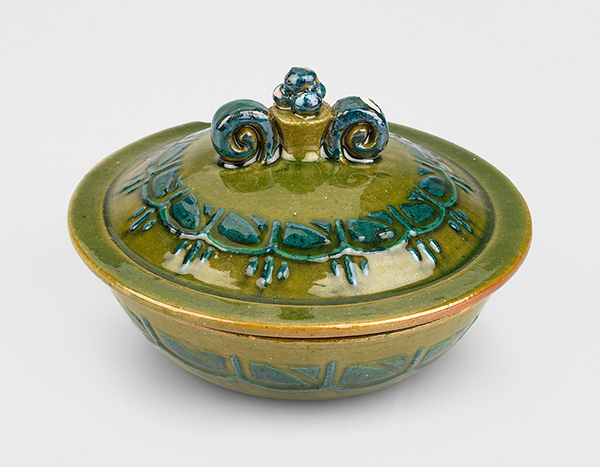
Made by Bendicht Loder-Walder, Heimberg, to a design by Nora Gross, 1905 (MHL No. 14).
Further, rather euphoric reports on the new ceramic creations date from May of 1905, when they were exhibited at the Museum of Applied Arts in Bern to great success (Le Nouvelliste vaudois dated 3rd May 1905, 2 – Gazette de Lausanne dated 13th May 1905, 3 and 5). As an aside it should be noted that the report in Le Nouvelliste provides a potential reason why Gross and the Knechts parted ways: “Miss Gross had initially been looking among the craftspeople in Ferney [the error in pinpointing the correct location occurred because the Knechts also had a workshop in Ferney-Voltaire] for a potter who would be capable of working to her designs; fortunately, however, the prejudices she encountered convinced her to broaden her search for the most suitable candidate to all of Switzerland. She eventually found him in Heimberg.”

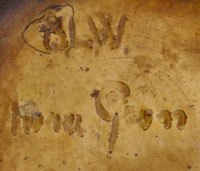
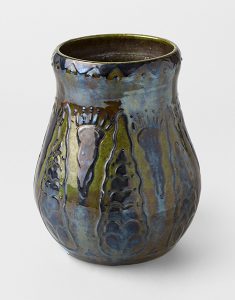
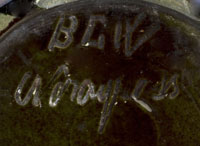
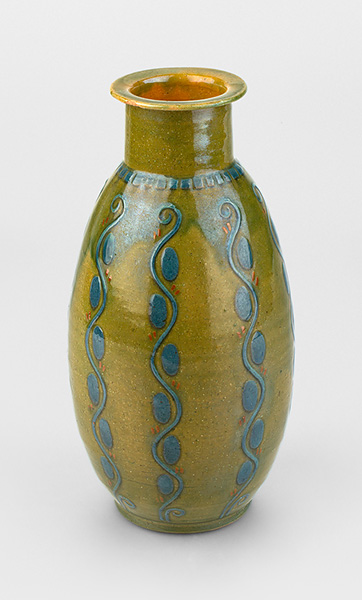
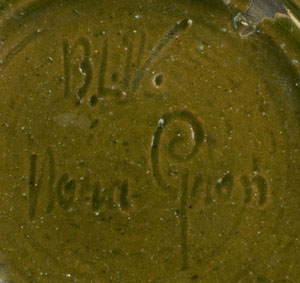
Pottery produced by Bendicht Loder-Walder and Nora Gross in the collection of the Historical Museum in Lausanne.
The vast majority of the ceramics produced by Loder-Walder bear the incised mark “BL (or BLW) – Nora Gross” and an incised number that identifies the shape. Five pieces are in the collection of the Historical Museum in Lausanne (MHL No. 14; MHL No. 17; MHL No. 18; MHL No. 25; MHL No. 26), three are at the Biel and Bern School of Visual Arts and Design.






The Swiss National Museum in Zurich has three vases by Nora Gross and Bendicht Loder-Walder in its collection (SNM LM-70629, SNM LM-70630, SNM LM-149623).










The Musée Ariana has 15 objects from this category, which were acquired from the former Museum of Arts and Crafts in Geneva in 1905 and 1906 (see Ball 1988 Cat. No. 2, 5, 7, 8, 10, 11, 14-16, 18-20, 23-26).


They include two highly decorative painted plates.
A further five examples can be found in the collection of the Lerbermatt Secondary School in Köniz. Unfortunately, we do not know when these pieces found their way into the collections of its predecessor institution, the State Seminary Bern – Lerbermatt. The marks on these pieces obviously differ from those on the last-mentioned group, but we have no information as to why the mark was changed.

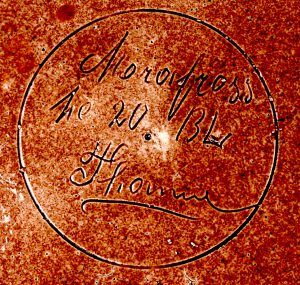
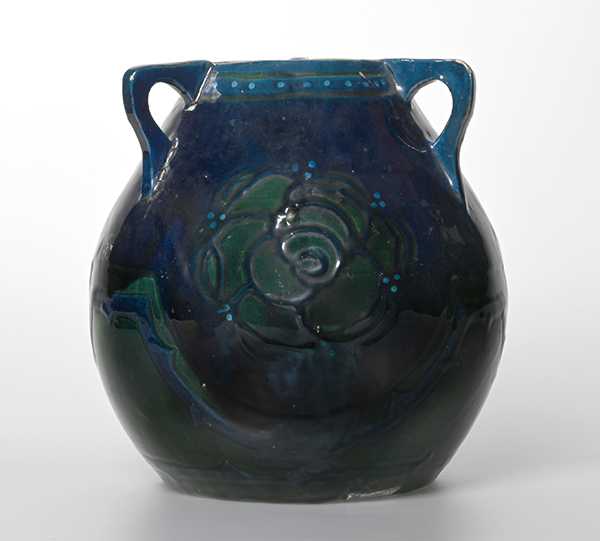
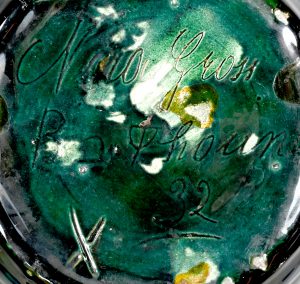
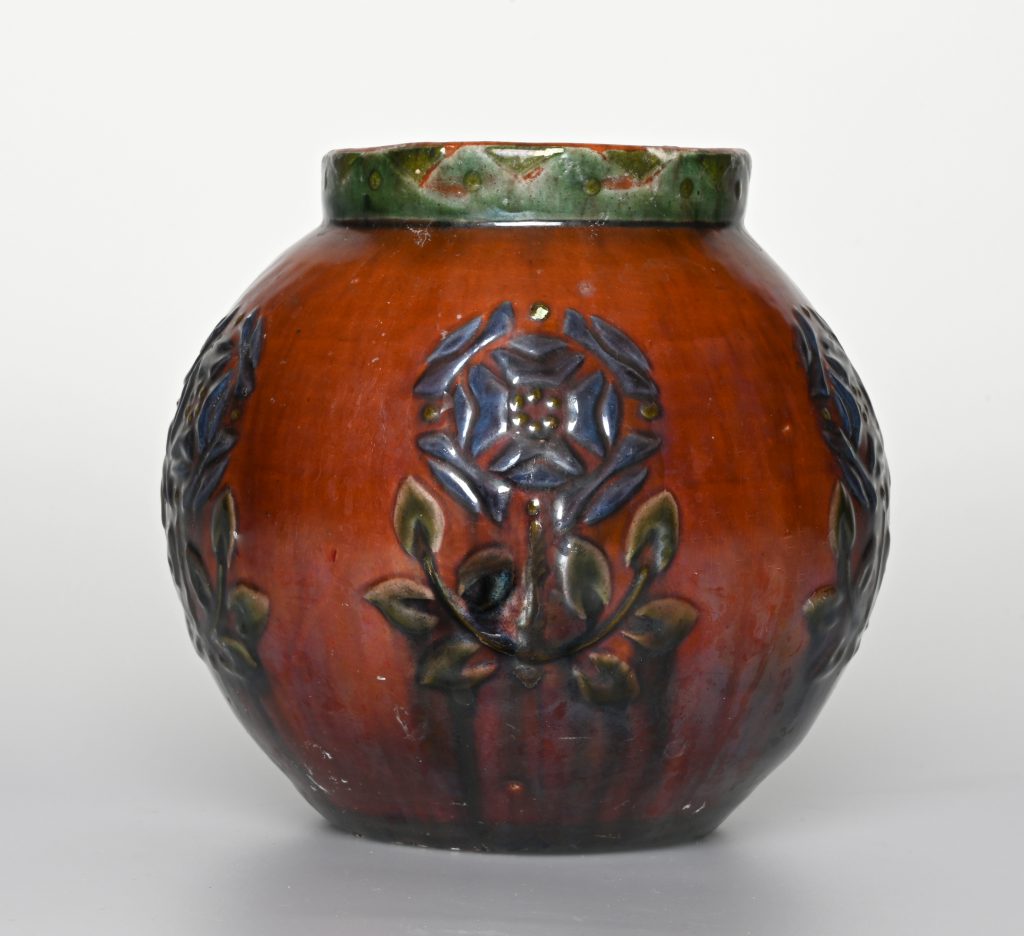
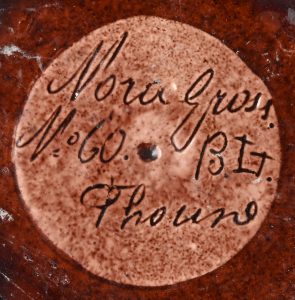
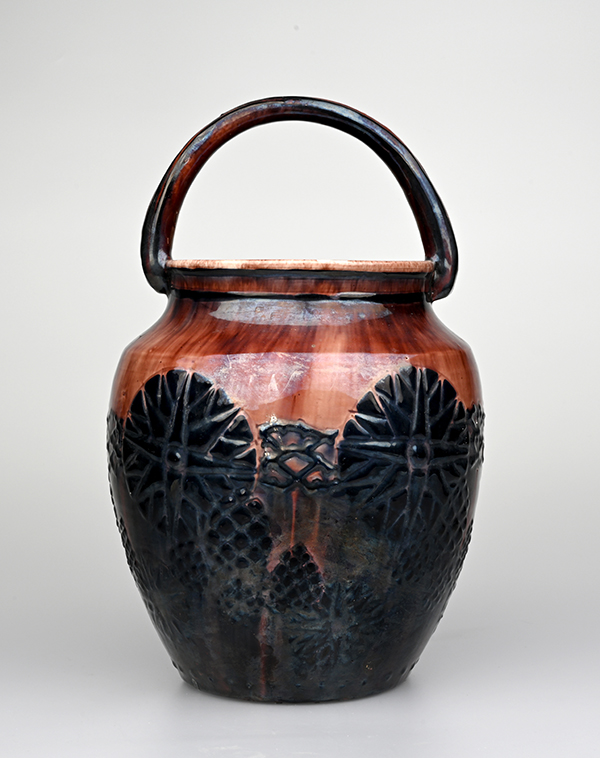
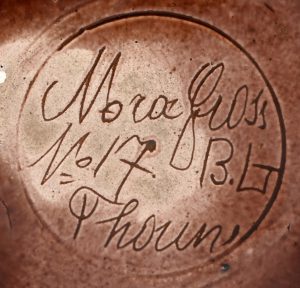
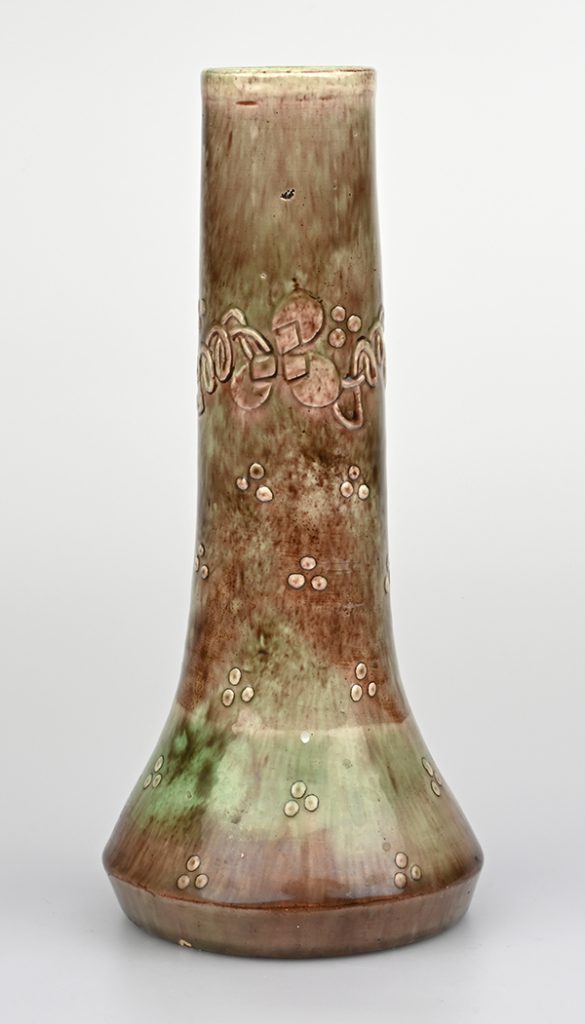
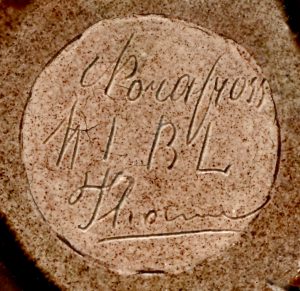
Collection of the Lerbermatt Secondary School in Köniz.
The collaboration with Bendicht Loder resulted in a product line that was much more refined, particularly in terms of colour. The slipped decorations were covered in polychrome glazes in a rich array of colours and with highlights in the poured-slip technique.
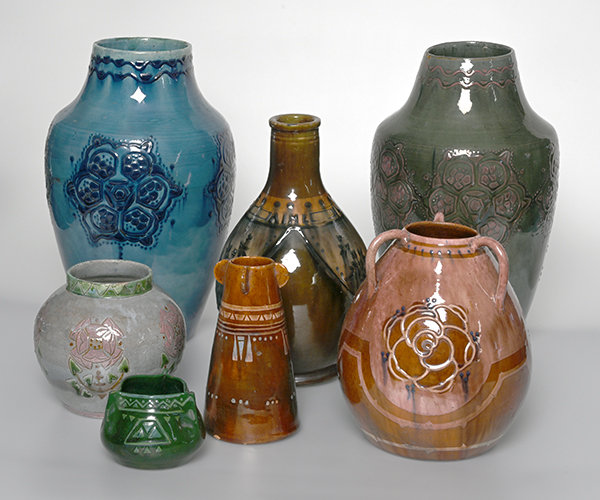
The ceramics produced by Loder-Walder bear the incised mark “BL (or BLW) – Nora Gross” and a stamped or incised number that identifies the shape. Private collection.
The Museum of Arts and Crafts in Zurich houses another vase from this period (ZHdK-KGS-08457).


Both the Historical Museum in Lausanne and the School of Visual Arts and Design in Bern and Bienne each have an unusual milk jug decorated with a red currant motif.
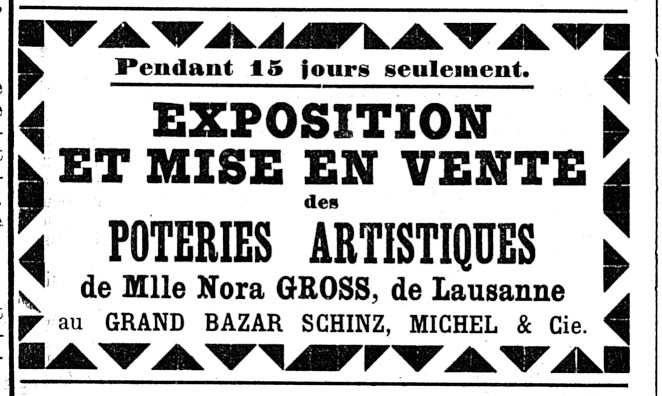
In the autumn of 1905, a large sales exhibition was staged both at the Grand Bazar in Neuchâtel and at the “Maison d’Art” in Geneva (La Suisse Libérale 42, No. 267, 14th November 1905 and 42, No. 296, 17th December 1905).
1905 Bendicht Loder-Walder’s contribution to the large “Thun Majolica Pyramid” at the Christmas Exhibition curated by the Museum of Applied Arts in Bern was mentioned in the Täglicher Anzeiger für Thun, 29, No. 287, dated 3rd December 1905 and No. 300, dated 19th December 1905. On this occasion, he had collaborated with Karl Loder-Eyer and with Gottfried Beutter from Thun, who had just taken over the running of the Musée Céramique.
In June 1906 La Grenette in Lausanne staged the “Second Exhibition of Female Painters from the French-Speaking part of Switzerland”. Nora Gross also exhibited some of her “pretty vases” (La Suisse Libérale 43, No. 132, 10th June 1906). In July 1906 some of her pottery was put on display in the shop window of Georges Clément on Grand-Rue. They were much admired and described in detail (La Liberté, 36, No. 156, 11th July 1906).
In 1906 the Thun city archivist Karl Huber (Huber 1906) published a notable appraisal of Loder-Walder’s work:
“I would like to introduce you to one notable producer of art pottery, and that is Bendicht Loder-Walder at Steffisburg-Station. He is a modest man whose health has suffered because of his profession, but he does not show it once he begins to talk about his beloved craft and takes us to see the beautiful results of his latest experiments. The practitioner is supported by sophisticated artists like Prof. Huttenlocher in Bern and Miss Gross in Lausanne. Using their original drawings and those of his talented daughter, Anna, he creates magnificent vessels of every shape that is known in Thun as well as wall plates which he covers in a brilliant glaze, the composition of which remains a closely guarded secret. The main colours are grey, brown and blue. Loder’s unusual glaze makes the motifs look so soft and dreamily delicate that the effect is rather intriguing. The decorations designed by Gross depict fish, conifer cones, hanging fruit, birds, flowers such as thistles and roses, etc. Another technique, known as flowing glaze, is used to achieve marvellous colour effects, which promise to have a bright future. He also produces beautiful utilitarian wares with alphorn players and other figures from Alpine life applied in the most up-do-date technique using brushes and thin paints. As far as we know, the products made by Loder-Walder are mainly sold in Miss Gross’s shop in Lausanne. Benedikt Loder’s experiments have also been applied to the production of a sturdier type of utilitarian crockery. By using colourful glazes and omitting the application of colour between the clay and the glaze, he has been able to create a beautiful but robust product, which holds its own, even in comparison to Schaffhausen ware, which is renowned for its durability” (Huber 1906, 295-296).
In November 1906 some of Nora Gross’s products were put on display in the Weil art dealership on Bahnhofstrasse in Zurich and were very favourably reviewed by the NZZ newspaper (Neue Zürcher Zeitung, archive) on 20th November 1906.

Her products were also admired and sold in Basel (Illustrierte Schweizerische Handwerker-Zeitung No. 38, 20/12/1906, 613).
In 1906, Paul Wyss wrote: “Everybody must know the beautiful results Loder-Walder has achieved with his glazes. He is not the most prosperous, but in recognition of the fact that something had to change if the business was to recover, he sacrificed his time and materials to carry out lengthy experiments, and now surely none of us will begrudge him his success. May he now serve as an example to show that nothing can be achieved without trial and error, or without taking risks, but that by experimenting with open eyes and an open mind, we can without sacrificing everything, find new ways to improve our earnings.”
The Nora Gross vases that Loder-Walder produced clearly met Paul Wyss’s expectations of the “new style” of pottery: “Those of us who seek harmony strive to achieve uniformity in the overall effect of a vase. Essentially, it is supposed to be a large, beautiful and shiny patch of glaze that boosts the effect of a bunch of flowers much like a frame boosts the effect of a painting on a wall. Therefore, we pursue a certain degree of calm and a uniform effect in how we design a vase, rather than splashing some bright red in one area, and then some white in another, and then blue, and then green etc. A vase is supposed to give an overall impression of green or blue or red etc. In theory, this can be achieved by choosing a basic shade from the colour wheel and then using its neighbouring colours for the decorations; one shift to the left is balanced out by the same shift to the right, so that the basic tone that had been chosen in the first place remains to the fore. In practice the next step involves applying a transparent glaze of uniform colour on top of the other colours so that if it is blue, for instance, the underlying red will appear purple, and green will become blue-green; everything is covered in a blue haze, and the desired effect of blue is thus achieved” (Wyss 1906, 20). The close collaboration, initially with Bendicht Loder-Walder and later with Christian Frank-Jenny (1865-1950), allowed Gross’s characteristic designs to bring the ideas of the international reform movement which was expressed in the “modern style” to Heimberg (Messerli 2009, 68 and Ball-Spiess 1987).

1907 As well as Karl Loder-Eyer from Steffisburg, Bendicht Loder-Walder from Heimberg exhibited a majolica collection at the Christmas Exhibition of the Museum of Arts and Crafts in Bern. The Steffisburg Pottery Collective also had a majolica collection on display.
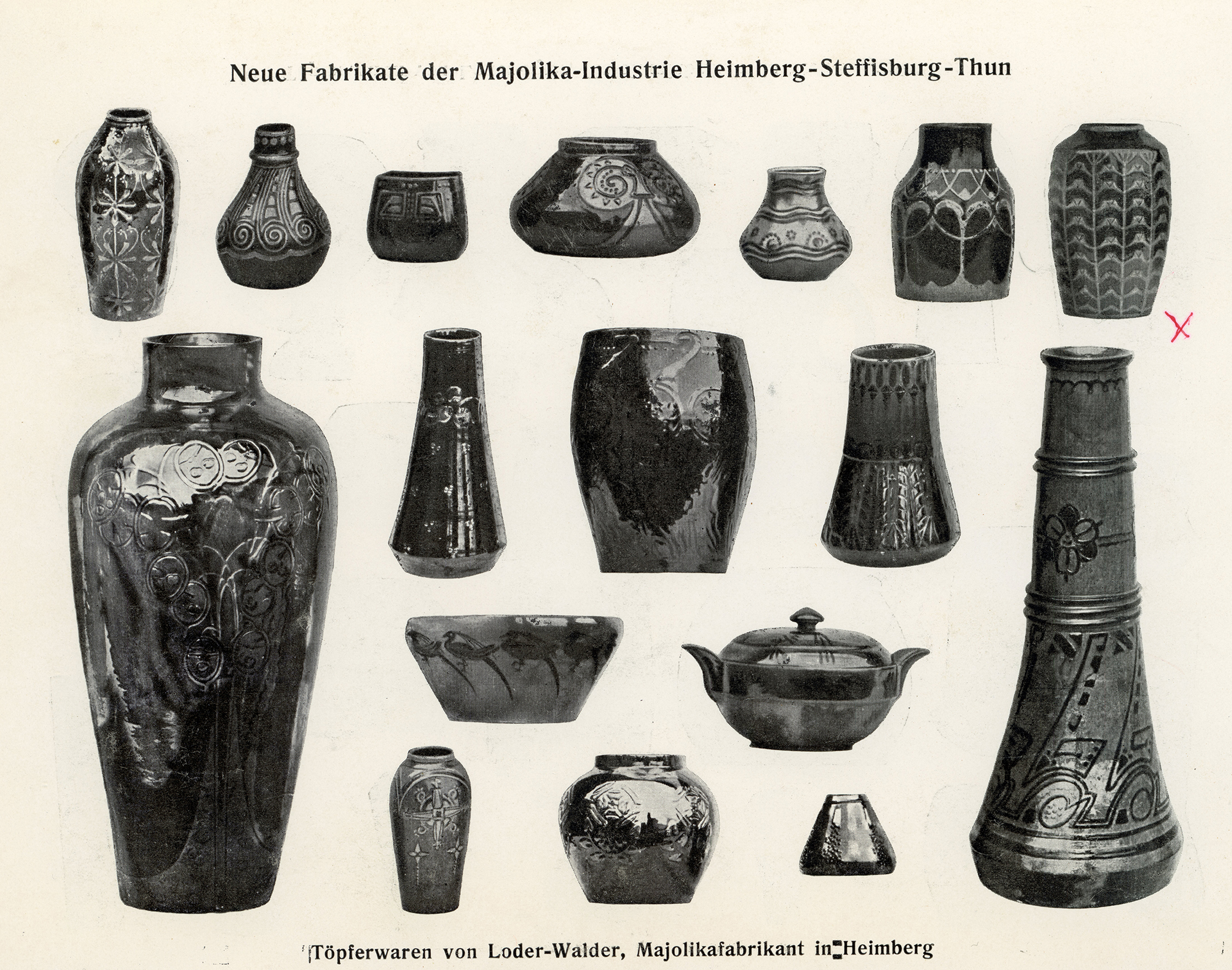
Ceramics by Bendicht Loder-Walder and Nora Gross presented at the Christmas Exhibition of the Museum of Arts and Crafts in Bern in 1907 (Jahresbericht 1907 des Kantonalen Kunstgewerbemuseums Bern).
A plate of photographs in the Annual Report by Director Oscar Blom (1908) shows the objects that were on display at the 1907 Christmas Exhibition. The shapes and decorations clearly hark back to Nora Gross.
1907 advertisement

Special winter edition of the Illustriertes Fremdenblatt von Thun und Umgebung dated 21/9/1907 (City Archive of Thun 7/2 AN 5.2).
The special winter edition of the Illustriertes Fremdenblatt von Thun und Umgebung dated 21st September 1907 contains an advertisement by Bendicht Loder-Walder promoting his speciality, “Modern Majolica”, while at the same time emphasising the fact that he also produces [Thun] majolica and everyday ceramic wares.
For some reason, we only know a very small number of these “classic” products. It is possible that his workshop did not usually mark them.









Der Bund, Volume 59, No. 148, 27th March 1908 Issue 02


Pottery produced by Adèle Schwander and Bendicht Loder-Walder in the collection of the Thun Castle Foundation.

Large bowl with horizontal lug handles modelled on Langnau examples, designed by Adèle Schwander, manufactured by Bendicht Loder-Walder, 1908. Swiss private collection, photo Christoph Messerli (Messerli 2009, Fig. 80).
1908 In March, Der BUND newspaper reported on a special exhibition at the Museum of Applied Arts in Bern, with ceramic objects created by Adèle Luise Schwander (1880-1949) and Bendicht Loder-Walder. It is not known how long their collaboration lasted.


After Bendicht Loder died (21/11/1909), the property and workshop at 310 Bernstrasse passed to his widow, and when she died on 13th July 1911, the estate went to their nine surviving children.
It was not until 1916 that they had the inheritance recorded in the land register (GBThun Bel I 3401, GBThun Bel I 3402). At that time, Ernst Hans Loder (1882-1958) was listed as a potter in Heimberg. Friedrich Loder (1890-?) worked as a potter in Bienne, and two of their sisters, Marie Martha Loder (1892-1917) and Marie Frieda Loder (1893-1917), worked as paintresses/decorators in Heimberg. The same was probably true for Mina Bertha Loder (1894-1919), who, in 1916, was still identified as a housekeeper. Eduard Rudolf Loder (1896-1971) was already listed as a “laboratory worker”. The other three siblings were still only children.
Bendicht Loder-Walder’s death in November 1909 did not mean the end of the production of Nora Gross’s designs for the workshop as it continued to operate and probably continued to employ the same pottery paintresses. This is may be further attested to by an exhibition staged in 1911 by the Société des peintres et sculpteurs suisses, the Swiss Society of Painters and Sculptors, at the Kunsthaus Museum in Zurich. The ceramic works by Nora Gross were described by Albert Baur, chief editor of the journal Wissen und Leben (Schweizer Monatsschrift für allgemeine Kultur, Vol. 8, 1911, 160), as “interesting ceramic works”. The NZZ newspaper, too, reported on the exhibition, specifically mentioning the fact that the pieces were made by Loder-Walder (9/4/1911, 20/4/1911, 29/4/1911). The notion that production continued at Loder-Walder’s workshop is also supported by statements made by Paul Wyss (1914, 150). A number of exhibits made by Loder-Walder to the designs of Nora Gross were put on display as part of the ‘23rd Group: Ceramics and Glass’, at the Bern State Exhibition in 1914. A comment in the list of exhibitors shows that Nora Gross’s ceramic designs were produced by pottery paintresses from the Loder-Walder workshop. It is interesting to see that Loder-Walder’s new collection was still identified as majolica: “Loder Brothers, Pottery, Heimberg. Production of majolica with the artistic cooperation of Ms. Nora Gross, Lausanne. Prompt execution according to her designs” (cited after Messerli 2009, 70). In this context, the technical report on the State Exhibition (Volume VI on Group 23, p. 73) offers the following critique: “The Loder Brothers from Heimberg exhibited ceramic wares to the designs of Ms. Nora Gross, Lausanne. Not much was new; we had encountered most of the exhibits at smaller arts and crafts exhibitions previously staged by the artist herself.”

Ceramics and textiles stand in the “Dörfli” [village] Bazaar at the 1914 National Exhibition in Bern (after Conradin 1914, 99).
In 1914, the Loder “Brothers” not only participated in the National Exhibition in Bern but were also among the suppliers to the Bazaar in the “Dörfli” [village].

1914 The Loder Brothers won a bronze medal at the National Exhibition in Bern (Oberländertagblatt_38_Nr. 263, 10/11/1914), though it is not clear exactly what it was awarded for. The BUND newspaper (Volume 65, No. 477, 9th October 1914 Issue 02) wrote:
“Swiss National Exhibition. Ceramic and glass wares. Visitors to the ceramic section of the National Exhibition are pleased to see such a beautiful variety of shapes, colours and decorations of glass, porcelain and ceramic wares on display in this hall. Almost inexhaustible quantities of raw clay are available in Swiss soil which leads to a substantial number of potters’ workshops in our country, whose greatest goal is to produce exquisite and practical ceramic wares, and in particular to redesign ancient shapes and give a contemporary feel to them, which again strives for the greatest possible simplicity and size of the contour lines and for the greatest possible harmony between shape and colour in the overall effect. All those squiggly rococo charms that were once all the rage on plates, pots, jugs and bowls have been replaced by the simple sobriety of the modern movement. That is why the majolica wares, bedecked as they are with heavy, relief-like flower and tendril motifs, feel to us today like a greeting from a bygone era which is now alien to us, and seem almost like something handed down to us from a long and venerable folkloristic past. Thun majolica, as we all know, is known all over the world for its colourful decoration that makes it so very quaint and primevally vigorous. The majolica factories at Steffisburg, Heimberg and Thun are also showing highly original and exquisite wares (K. Loder-Eyer, Loder Brothers, E. Lengacher).” The newspaper reports from 1914 were the only time the term “Loder Brothers” was used.


In 1916, the pottery produced by Bendicht Loder-Walder and Nora Gross gained significant recognition when Elisabeth Gött-Strasser reviewed it in a publication entitled “Die kunstgewerbliche Arbeit der Frau in der Schweiz” [The arts and crafts created by women in Switzerland]” (Anner 1916).
In 1922, Ernst Hans Loder bought out his siblings, thus acquiring the entire property at 310 Bernstrasse and from then on, continued to produce everyday wares and late Thun majolica (“Chrutmuster” herbal patterns?), probably on his own. His workshop was never again mentioned in the press. In 1932, Loder went bankrupt which led to the property being sold to factory worker Rudolf Amstutz, who had no use for the two potters’ kilns.


On the left: Heimberg, 310 Bernstrasse. The vertical kiln (70) after it was excavated. The outer hovel of the kiln is visible in the foreground, and behind it the sunken floor of the firing chamber. The vaulted floor with remains of a floor with circular perforations can be seen on the left-hand side of the image. The walls of the firing chamber are severely vitrified. The stoking-pit of the kiln (10) is visible in the background. Photo Archäologischer Dienst des Kantons Bern, Marco Amstutz.
On the right: Heimberg, 310 Bernstrasse. Overview of the excavated area with both kilns and the north wall of the house built in 1805. Photo Beat Straubhaar, Heimberger Dorfbote.
Following an architectural survey carried out by the Archaeological Service of the Canton of Bern in 2019 (Frey 2022), the house was demolished in June 2021 to make way for a new building. It had long been unoccupied and had fallen into disrepair.

Heimberg, 310 Bernstrasse. A selection of finds put on display at an open-excavation day. Photo Beat Straubhaar, Heimberger Dorfbote.
The remains of both potters’ kilns were recorded and their last fills recovered. A study of the archaeological finds would be most welcome.
Acknowledgements
We are very grateful for the assistance of Maya Hürlimann-Zumbrunn, Administrator, Thun Chancellery/Town Archive, Jonathan Frey, Bern, Andreas Kistler, Bäriswil, Andreas Liesch, Stierva, Margret Loder-Rettenmund, Ebikon, Beat Straubhaar, Heimberg.
Translation Sandy Haemmerle
References:
Anner 1916
Franziska Anner, Die kunstgewerbliche Arbeit der Frau in der Schweiz, Chur 1916.
Ball-Spiess 1987
Daniela Ball-Spiess, «Wie ist das Kunstgewerbe in der Schweiz zu heben und zu pflegen?» Der Beitrag von Nora Gross (1871–1929) zur ästhetischen Erziehung. Dissertation, Universität Basel, Bern 1987.
Ball 1988
Daniela U. Ball, Nora Gross (1871-1929), in: Genava 36, 1988, 117-135.
Barten 1998
Sigrid Barten, Nora Gross, in: Cerâmica da Suìça do Renascimento aos nossos dias. Ceramics from Switzerland from Renaissance until the Present. Museu Nacional do Azulejo, Lissabon 1998, 141-146.
Frey 2022
Jonathan Frey, Archäologische Forschungen: Töpferöfen in Heimberg, in: Keramik-Freunde der Schweiz, Bulletin 99. 2022, 13-16.
Huber 1906
Karl Huber, Thuner Majolika, in: Illustriertes Fremdenblatt von Thun und Umgebung, 1906, 258-259, 278-279, 294-296.
Messerli 2009
Christoph Messerli, Von der Souvenir- zur Studiokeramik. Die Berner Keramik im 19. und 20. Jahrhundert. Lizentiatsarbeit, Institut für Kunstgeschichte des Universität Bern, Bern 2009.
Messerli Bolliger 1991
Barbara E. Messerli Bolliger, Der dekorative Entwurf in der Schweizer Keramik im 19. Jahrhundert, zwei Beispiele: Das Töpfereigebiet Heimberg-Steffisburg-Thun und die Tonwarenfabrik Ziegler in Schaffhausen, in: Keramik-Freunde der Schweiz, Mitteilungsblatt 106, 1991, 5-100.
Wyss 1906
Paul Wyss, Stand, Probleme und Hebung des Töpfergewerbes, Vortrag von Herrn P. Wyss, Zeichner am Gewerbemuseum Bern (Umschlag: Nach dem Vortrage von Hrn. P. Wyss … in Bern niedergeschrieben von Hermann Röthlisberger, Sek.-Lehrer in Steffisburg, No. 14-19 Oberländer Volksfreund Jhrg. 1 (Hrsg.), Steffisburg 1906.
Wyss 1914
Paul Wyss, Keramische und Glaswaren 23. Gruppe. Katalog B zur Schweizerischen Landesausstellung Bern, Genf/Bern 1914.

